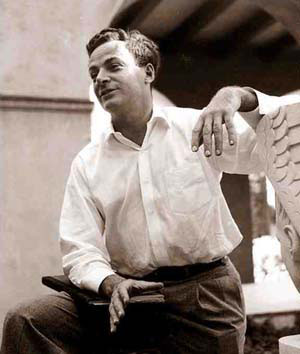| Posted: Oct 22, 2009 | |
Feynman and nanotechnology - anniversary reflections |
|
| (Nanowerk Spotlight) In December 2009 we will receive a series of reminders of the fiftieth anniversary of Richard Feynman’s noted talk, "There’s Plenty of Room at the Bottom". As commentaries appear in scientific journals, the nanotechnology community will have multiple opportunities to think about the role of Feynman’s talk in the history of nanotechnology. | |
| "There’s Plenty of Room at the Bottom" was originally a talk by Richard Feynman at the annual meeting of the American Physical Society in Pasadena, California, on December 29th, 1959. Two months later it appeared as an article in the Caltech magazine, Engineering & Science. | |
 |
|
| Richard Feynman (Courtesy of The Archives, California Institute of Technology) | |
| It then appeared five more times, including two abridged versions, in a journal, three magazines, and a book, in 1960-62. Almost thirty years later it began to re-appear, so that this talk has been published eleven times through 1999. A second talk by Feynman, “Infinitesimal Machinery”, was closely related to “Plenty of Room”. When he delivered “Infinitesimal Machinery” in Pasadena CA in 1983, Feynman called it “Plenty of Room at the Bottom, Revisited”. This update to his 1959 thoughts has been published twice, in 1993 and 2006. | |
| Feynman’s 1959 talk has been widely hailed as the origin of nanotechnology. It is a comprehensive vision of controlling matter at the nanoscale, including controlling individual atoms. It also describes a technique for writing text with the beam of an electron microscope, and then making silicon molds of the writing, from which additional copies would be made, with other electron microscopes then reading the copies. Other parts of his vision are more sweeping, less detailed. One can imagine that it would have been a pleasure to be in the audience when Feynman spoke: the scientific details he described are fascinating, and the challenge he delivered to his colleagues, not just to study atoms but in fact to control them, is exciting. | |
| The origin-of-nanotechnology diagnosis of Richard Feynman’s talk is especially prominent in the views of Eric Drexler and the Foresight Institute. Drexler and the institute he founded have stated or implied that Feynman’s vision is the correct vision of nanotechnology, that Drexler and Foresight have a mission to nurture that vision, and that the term “nanotechnology” has been misused or illegitimately co-opted by misguided persons. | |
| The view that the beginning of nanotech can be traced directly to Feynman’s talk is frequently heard even among people who are not connected to Eric Drexler’s views of nanotechnology. | |
| In 2005 I presented a revisionist view of the historical role of Feynman’s talk. "Apostolic Succession" (pdf download, 508 KB) appeared in Engineering & Science, the same Caltech magazine that originally published “Plenty of Room”. | |
| In that paper and in "Reading Feynman into Nanotechnology" (pdf download, 504 KB) a more detailed version of my argument, I traced the history of Feynman’s talk and its relation to the history of nanotechnology. I found that Feynman’s talk was practically ignored in the scientific literature in for the first twenty years after it was published, despite having been published six times in the first three years. For example, the invention of scanning probe microscopy, one of the most important cornerstones of nanotechnology, owed nothing to “There’s Plenty of Room at the Bottom”, in my analysis. Serious interest in “Plenty of Room” in the scientific literature became noticeable in the early 1990s, when the tools of nanotechnology became well developed, and when the term “nanotechnology” began to achieve some cachet as a sexy new scientific field. | |
| At this point, there are two very different views of the role of Feynman’s talk in the history of nanotechnology: | |
| 1. Everybody knows that Feynman’s “Plenty of Room” is the origin of nanotech. | |
| 2. The emergence of nanotech had little to do with Feynman’s talk. | |
| “There’s Plenty of Room at the Bottom” is a thoughtful and eloquent statement about what scientists ought to do with matter at the nanoscale. This paper is a pleasure to read, and it is not hard to imagine that the knowledge and practices now called “nanotechnology” are a fulfillment of Feynman’s vision. Nevertheless the historical evidence indicates that nanotechnology would have arrived at its current status even if Feynman had never presented his views, whether verbally or in writing, fifty years ago. | |
| I suggest that we use the December 2009 anniversary to reflect upon the history of nanotechnology, including the role of Feynman’s talk. And, at the risk of encouraging you to discredit my own research, I invite readers to find and share evidence that “Plenty of Room” influenced the early years of nanotech. Is there evidence that leading scientists were inspired to contribute to nanotechnology in its early years because of Richard Feynman’s talk? | |
| By Chris Toumey. Chris is a cultural anthropologist in the University of South Carolina NanoCenter: [email protected] | |
|
Become a Spotlight guest author! Join our large and growing group of guest contributors. Have you just published a scientific paper or have other exciting developments to share with the nanotechnology community? Here is how to publish on nanowerk.com. |
|
